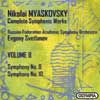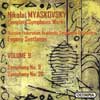Myaskovsky Complete Symphonies Vol 8
Ultra-Romanticism, Soviet expressionism and an accessible rarity expand our appreciation of a prolific Russian
View record and artist detailsRecord and Artist Details
Composer or Director: Nikolay Myaskovsky
Genre:
Orchestral
Label: Olympia
Magazine Review Date: 4/2003
Media Format: CD or Download
Media Runtime: 70
Mastering:
Stereo
DDD
Catalogue Number: OCD738

Tracks:
| Composition | Artist Credit |
|---|---|
| Symphony No. 8 |
Nikolay Myaskovsky, Composer
Evgeni Svetlanov, Conductor Nikolay Myaskovsky, Composer Russian Federation Academic Symphony Orchestra |
| Symphony No. 10 |
Nikolay Myaskovsky, Composer
Evgeni Svetlanov, Conductor Nikolay Myaskovsky, Composer Russian Federation Academic Symphony Orchestra |
Composer or Director: Nikolay Myaskovsky
Genre:
Orchestral
Label: Olympia
Magazine Review Date: 4/2003
Media Format: CD or Download
Media Runtime: 70
Mastering:
Stereo
DDD
Catalogue Number: OCD739

Tracks:
| Composition | Artist Credit |
|---|---|
| Symphony No. 9 |
Nikolay Myaskovsky, Composer
Evgeni Svetlanov, Conductor Nikolay Myaskovsky, Composer Russian Federation Academic Symphony Orchestra |
| Symphony No. 20 |
Nikolay Myaskovsky, Composer
Evgeni Svetlanov, Conductor Nikolay Myaskovsky, Composer Russian Federation Academic Symphony Orchestra |
Author: David Gutman
Like the Fifth and Sixth, the Eighth Symphony (1924-25) is a nationalistic epic, based on thematic material in Myaskovsky’s most overtly appealing, Russian vein. And yet, notwithstanding some attempt to deploy the more colourful harmonic and instrumental palette of the Seventh, its ideas are developed in such a staid, academic manner that no real sense of momentum is generated. At least the piece can boast an exceptionally beautiful, if overlong, slow movement. Placed third, this unexpected take on Rachmaninov’s Isle of the Dead often sounds like Bax at his most oriental. Whether you’ll find the lapping, rocking motion seductive or merely soporific I cannot predict. Safer to say that Robert Stankovsky’s Slovakian recording (listed above) is effectively outclassed, not least because he offers no coupling.
Svetlanov’s makeweight is the Tenth (1927), an altogether more concentrated statement in which the sprawling Scriabinesque supernova has imploded into a dissonant white dwarf. Its single movement dispenses with obvious melody, presumably affected by Prokofiev’s brand of Parisian modernism albeit with César Franck, Scriabin and even Schoenberg lurking somewhere in the mix.
Tumultuous in every sense, while simultaneously reluctant to cut loose from Conservatoire norms, the score is neither an easy listen nor an easy play. Odd that it should have been intended for the conductorless Persimfans, a sort of ideologically motivated Orpheus Chamber Orchestra. Svetlanov’s Russians, despite limited rehearsal time, make a better fist of it than did Gottfried Rabl’s Viennese forces. Only don’t expect the composer’s patented autumnal glow: this is Russian-Soviet expressionism, sombre, stormy and oppressive.
No one following this series will want to miss out on Volume 9. Though written back-to-back with the seething chromatic Tenth, the Ninth (1927) is altogether more accessible and Slavic in feeling. At the same time, there is something typically ambivalent, even evasive, about its emotional trajectory. Of the traditional four movements, the first is marked Andante sostenuto which Svetlanov interprets very broadly indeed, not entirely convincing us that he has had sufficient rehearsal time to secure a proper sense of line; Sir Edward Downes and the BBC Philharmonic are a third faster. The Presto scherzo, which includes a melodic hook oddly reminiscent of ‘I saw three ships’, needs a sharper focus, too. All is forgiven in the Lento molto third movement, not perhaps ideally polished here but always sensitively handled. The main theme, launched by solo clarinet over another rocking figure, is exquisite; other elements include a Brucknerian chorale and an extraordinary episode in which woodwinds call and hoot anxiously over quasi-Sibelian strings. The finale brings unconvincing jollity and the usual cyclical contortions. Further listenings may or may not bring it all into tighter focus.
Technically speaking, the players have less to worry about in No 20 (1940). This is ultra-lucid, utterly professional stuff, with nothing to alarm the avatars of Soviet cultural policy. The first movement offers a controlled sort of exhilaration, while the central Adagio is nostalgic certainly but uplifting, too. Its main theme returns in triumph to cap (and brassily) an otherwise almost Borodin-like finale. I can’t imagine why we haven’t had the piece on disc before. The recording per se is warm, resonant and lively – flattering some tentative string textures – if scarcely state of the art.
Explore the world’s largest classical music catalogue on Apple Music Classical.
Included with an Apple Music subscription. Download now.

Gramophone Digital Club
- Digital Edition
- Digital Archive
- Reviews Database
- Events & Offers
From £9.20 / month
Subscribe
Gramophone Club
- Print Edition
- Digital Edition
- Digital Archive
- Reviews Database
- Events & Offers
From £11.45 / month
Subscribe
If you are a library, university or other organisation that would be interested in an institutional subscription to Gramophone please click here for further information.






